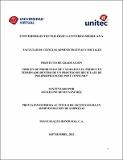JavaScript is disabled for your browser. Some features of this site may not work without it.
Mostrar el registro sencillo del ítem
Origen de problemas de calidad en el producto terminado dentro de un proceso de reciclaje de polipropileno de post Consumo
| dc.contributor.advisor | Silvia Elizabeth Vallejo Cerrato | es_ES |
| dc.contributor.author | Jackeline Reyes Sánchez | es_ES |
| dc.date.accessioned | 2023-12-06T01:09:00Z | |
| dc.date.available | 2023-12-06T01:09:00Z | |
| dc.date.issued | 04/12/2023 | |
| dc.identifier.uri | https://repositorio.unitec.edu/xmlui/handle/123456789/12840 | |
| dc.description.abstract | La investigación que a continuación se presenta pretende plantear el problema de origen y causas de contaminación cruzada en un proceso de transformación o reciclaje de plástico de polipropileno en la empresa Recicladora Eco Life de México S.A. de C.V. Empresa dedicada al reciclaje de polipropileno con 7 años activos en la industria local de Puebla, México. La empresa objeto de estudio solo transforma en su proceso de producción el polipropileno post consumo, por lo tanto, se ha recopilado información específica de características, usos y origen del plástico de polipropileno a través de diversas fuentes literarias y desde sitios web de empresas de soluciones industriales. El objetivo de la conceptualización es entender el proceso, términos y los sistemas utilizados en el rubro de reciclaje y así aplicar el mejor análisis de la información. La investigación persigue cuatro hipótesis para identificar el origen y causa de los problemas de contaminación cruzada en el proceso de reciclaje, primeramente se presenta los parámetros que el producto terminado debe cumplir para ser vendido a los clientes siendo los contenidos de metales ferrosos y no ferrosos el parámetro más importante, se identifica la etapa central del proceso donde se lleva a cabo la separación automatizada y limpieza de materiales siendo la etapa de flotación la parte del proceso que brindará las repuesta al origen de la contaminación. Se describen habilidades y capacidades que los Operarios de la empresa deben desarrollar para llevar a cabo las actividades que los puestos de interés para la investigación requieren y las necesidades que la empresa tiene en cuanto a la distribución y automatización en sus instalaciones y principalmente en la etapa central del proceso investigado. Se describe como se llevó a cabo la recopilación de información directa a través de técnicas investigativas cuantitativas y cualitativas aplicadas a involucrados directos en el proceso de producción utilizando la técnica de encuesta y el instrumento de recolección de datos, el cuestionario. El objetivo del diseño del cuestionario fue descartar o reafirmar cada una de las 4 hipótesis planteadas del problema. | es_ES |
| dc.description.sponsorship | N/A | es_ES |
| dc.format | es_ES | |
| dc.language | Español | es_ES |
| dc.publisher | Universidad Tecnológica Centroamericana UNITEC | es_ES |
| dc.rights | Attribution-NonCommercial-ShareAlike 3.0 United States | * |
| dc.rights.uri | http://creativecommons.org/licenses/by-nc-sa/3.0/us/ | * |
| dc.source | Universidad Tecnológica Centroamericana UNITEC | es_ES |
| dc.subject | Polipropileno | es_ES |
| dc.subject | Soluciones industriales | es_ES |
| dc.subject | Problemas de contaminación | es_ES |
| dc.title | Origen de problemas de calidad en el producto terminado dentro de un proceso de reciclaje de polipropileno de post Consumo | es_ES |
| dc.type | Other | es_ES |
| dc.description.abstractenglish | The research presented below aims to raise the problem of origin and causes of cross contamination in a process of transformation or recycling of polypropylene plastic in the company Recicladora Eco Life de México S.A. of C.V. Company dedicated to recycling polypropylene with 7 years active in the local industry of Puebla, Mexico. The company under study only transforms post-consumer polypropylene in its production process, therefore, specific information on the characteristics, uses and origin of polypropylene plastic has been compiled through various literary sources and from solutions company websites. industrial. The objective of conceptualization is to understand the process, terms and systems used in the recycling sector and thus apply the best analysis of the information. The research pursues four hypotheses to identify the origin and cause of the cross-contamination problems in the recycling process. First, the parameters that the finished product must meet to be sold to customers are presented, with the content of ferrous and non-ferrous metals being the The most important parameter, the central stage of the process is identified where the automated separation and cleaning of materials is carried out, with the flotation stage being the part of the process that will provide the answer to the origin of the contamination. Skills and capabilities that the company's Operators must develop to carry out the activities that the positions of interest for the research require and the needs that the company has in terms of distribution and automation in its facilities and mainly in the stage are described. central to the investigated process. It is described how the collection of direct information was carried out through quantitative and qualitative investigative techniques applied to those directly involved in the production process using the survey technique and the data collection instrument, the questionnaire. The objective of the questionnaire design was to discard or reaffirm each of the 4 hypotheses of the problem. | es_ES |
| dc.coverage | Puebla, México | es_ES |
| dc.catalogador | Clelia Joselin Lanza Canales | es_ES |
| dc.faculty | Facultad de Ciencias Administrativas y Sociales | es_ES |
| dc.thesis.degreename | Licenciatura en Administración de Empresas | es_ES |
| dc.codigocarrera | L-16 | es_ES |
| dc.thesis.degreelevel | Pregrado | es_ES |
| dc.discipline | Administración y Negocios / Business and Management | es_ES |
| dc.ddc | 363.7 - SA194 | es_ES |
| dc.campus | Universidad Virtual | es_ES |
| dc.collection | Trabajo de Investigación | es_ES |
| dc.date.terna | 2023-11-06 |
Ficheros en el ítem
Este ítem aparece en la(s) siguiente(s) colección(ones)
-
Trabajo de Investigación [132]
Excepto si se señala otra cosa, la licencia del ítem se describe como Attribution-NonCommercial-ShareAlike 3.0 United States



